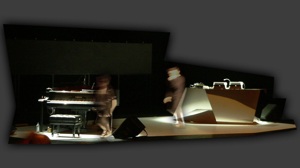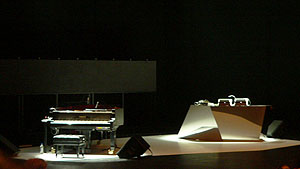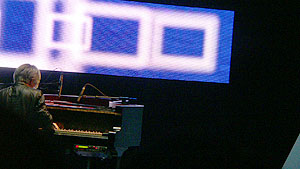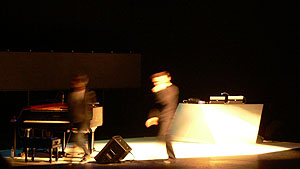
Ryuichi Sakamoto and Alva Noto
Barbican
13th October 2005
Sakamoto begins by reaching into the body of the piano to create deep, thunking notes followed by carefully placed piano chords, while Noto shadows him with angled high tones and deep, bass rumbles. The performers are lit by the intensely bright screen behind them which displays white circles that flit to and fro in response to the music. The audience’s faces are illuminated by a flicker all-too similiar to that of the cathode ray tube. The music’s stark elegance is mirrored in the simplified forms of these visuals, but it distracts this member of the audience from the primary concern of the music. (Seeing is a manifestly different act than hearing, provoking a much more literal analysis of sensation and inevitably reduce the abstraction and subtlety of the musical.) I close my eyes and although the brightness penetrates my eyelids, I begin to grasp the fascination of the music. It lies in the drama of contrasts created by the sheer dynamic range of Noto’s responses to Sakamoto’s playing. The higher pitches are only just audible and beg the question whether there’s significant sonic activity occurring beyond the audible. The range of sound that Noto’s electronics explores places the piano’s seven octaves into a tonal middle ground, whatever the subtlety of its voicings. While suggesting a specific variety of etiolated emotion and myriad cultural associations, the instrument’s presence also prompts a questioning of the role of the electronic in this context.
Alva Noto’s contributions exploit dance music’s fascination with sonic extremes. Conceptual art’s recognition of the importance of context (cf. Duchamp’s urinal) is obliquely mirrored by Nicolai’s transposition of these facets out of the club and into the concert hall. The interpretation is, however, subtle and indirect. Noto’s synthetic bass is powerfully sculptural, while in the higher registers, he forms meter out of mica shards rather than percussion sounds. The result is an intense morse codification of rhythm, speech reduced to signal so brief as to be almost not there. As the concert progresses, it becomes increasingly clear that the conjunction of acoustic piano and electronics creates the spaces within which the music develops. Aided by powerful amplification, the music creates a dynamic set of sonic co-ordinates within the fixed architecture of the concert hall. The experience is intensely spatial. The resulting music is like a hybrid of art gallery and scientific laboratory, of intuition and deduction.



